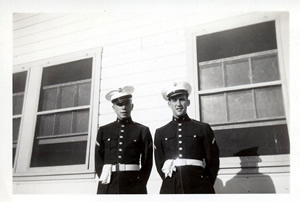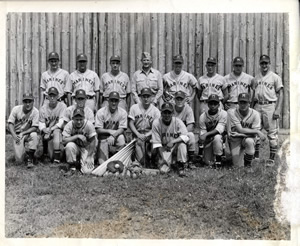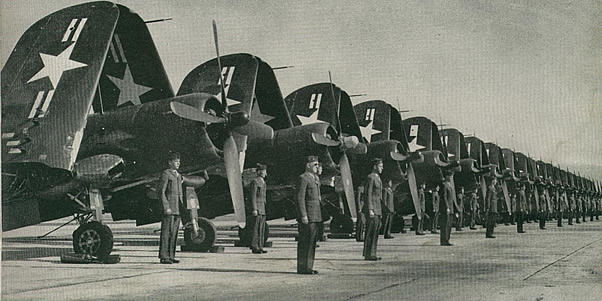Farmers to Flyers
Museum Showcases the Stories of Marines at El Toro
April 14, 2009
By Mimi Ko Cruz
They are dying and their stories about wartime life in Orange County are going with them.

A pair of privates first class pose for a photo in 1947.
Fortunately, the oral histories of 150 people, stationed at El Toro Marine Corps Air Station from 1942 to 1953, have been preserved on tape by Cal State Fullerton faculty and students.
The ongoing El Toro Marine Corps Air Station Oral History Project, funded by the Orange County Great Park Corporation, will be showcased as part of “Farmers to Flyers: MCAS El Toro and Mid-Century Orange County.” The exhibition opens April 18 and runs through Dec. 10 at the Orange County Agricultural and Nikkei Heritage Museum at the Fullerton Arboretum. It features photographs, artifacts and some of the oral histories.
Among the stories in the exhibit:
- Cpl. Faye Shumway remembers the very day her future husband told her he might be proposing to her on their date later that night: “I got so excited. I had this electric drill in my hand and it got caught in my Dungarees … and I’m drilling into my leg…. It did make a big hole in my leg…. He did ask me to marry him that night, and, of course, we did get married after we were discharged.”
- Sgt. William Rickenbach recalls the day he arrived at El Toro in a dive bomber aircraft during World War II: “It was 1943. We flew out the coast in these two-seaters and while we were quite familiar with the airplane, I’m not so sure the pilot was…. You are looking down and in trouble because this thing is starting to sputter badly, and I am now worried. What do I know about airplanes? I should have been in tanks. And, we were looking down and suddenly it wasn’t brush any more. It was bean fields, just bean fields, and you know, I thought that was strange…. We all got in safely and there we were, on the station.”
- Tech. Sgt. Vera Nelson muses about the approved lipstick and nail polish color permitted to women in the Corps: “Made by Elizabeth Arden, it was called ‘Montezuma Red.’ And, it exactly matched the red card on our green service cap.”

An El Toro Marine baseball team.
The exihibit also features the oral histories of: Lowell Benton, Capt. William Brems, Major Edward Carmichael, Gen. John Davis, Lt. Col. William Duncan, Col. Shelby Forrest, Master Sgt. David Gaylord, M. Gy. Sgt. Helen Hannah, Roberta Herlihy, Col. Harvey Jensen, Lt. Col. Jessie Lewis, Randi Miller, Lt. Gen. Frank Petersen, Staff Sgt. Charles Porter, Major Art Rawlings, Privat First Class Edmundine Raymond, Lt. Col. Roger Sanders, Capt. Larry Stites, the late Lt. Col. Nita Bob Warner and Private First Class Maxine Wehry.
“ ‘ Farmers to Flyers’ tells a very important story about mid-century Orange County,” said Natalie M. Fousekis, associate professor of history and director of Cal State Fullerton’s Center for Oral and Public History.
“While the exhibit and the El Toro Marine Corps Air Station Oral History Project tell the stories of the men and women who lived and worked on the base in these early years, they also are part of a larger history of the region itself — not just the base, but the land and the people surrounding it," she said. "The interviews featured in this exhibit will help scholars and citizens recover the history of Orange County, its people, and the dramatic changes that occurred in the later half of the 20th century.”
A team of mostly history students worked on the exhibit, curated by grad student Sarah Barca.
The team grew out of a class, “Introduction to Public History” taught last semester by Benjamin Cawthra, assistant professor of history.
“The class introduces undergraduate history majors and graduate students to a wide range of thinking on how public history is performed in museums, historic sites, online, and in historic preservation” Cawthra said. "The class project involved breaking down the El Toro exhibition into sections and conducting research for objects and images that would tell the story of El Toro and its relationship to midcentury Orange County.”
As the veterans and others who lived at the El Toro base age, "it’s important to capture their stories before the opportunity is lost,” said Michelle Antenesse, a graduate student pursuing her master’s degree in history, and the exhibit’s project manager. “The veterans are providing valuable information about their experiences, life in mid-century Orange County and our history. This exhibit is meant to showcase that life and how it has changed.”
In addition to the El Toro oral history piece of the exhibit, other sections cover: the agriculture history of the land, examining the acquisition of the land as well as the construction of the base; the beginning of the Cold War population boom in Orange County and its transition away from an agriculture-based economy, as well as the development of freeways; and the recent controversy over the plans for the land after the closing of the base and the development of the Great Park.


